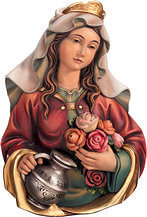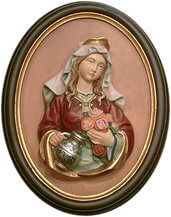
Saint Elizabeth
(10 products)She was, it is fair to say, a true revolutionary. Saint Elizabeth was a woman far ahead of her time. Her family and politics had their own plans for this clever woman, who ultimately determined her own path in life.
All prices are including VAT but excluding delivery










Her life
Saint Elizabeth was born as Countess Elizabeth of Thuringia on 7.7.1207 and died on 17.11.1231 in Marburg an der Lahn. Her birthplace is not certain: either Pressburg or Sárospatak in Hungary. On November 19, the date of her funeral, the name day of Elizabeth is celebrated.
Already in infancy, Landgrave Hermann of Thuringia was promised Elizabeth's hand - a procedure that was not unusual in the high nobility at that time. Elizabeth was raised at the court of Hermann of Thuringia. When Hermann died in 2017, she married his younger brother Ludwig. There were loud debates about the dowry she was to bring into the marriage and demands were made to disown the bride. The noble couple's marriage was unusual for the time: Elizabeth accompanied her husband on journeys and sat next to him at meals.
Elizabeth rejected the splendor found at court early on. Her mother-in-law, Sophie of Thuringia, gave the young Elizabeth a valuable prayer book. The bright girl turned more and more to religion and devoted herself increasingly to the poor. Today's sources indicate that her husband supported Elizabeth in her pious work. Elizabeth gave birth to three children in this marriage.
At the end of the 12th century the Beguines became popular - a poverty movement of the church founded by women. The ideas of the Beguines and those of Francis of Assisi were enthusiastically received by Elizabeth. The noblewoman renounced splendid celebrations and began to give away her possessions. She made sure that her servants distributed cloths and other alms to poor and sick people. During a famine, she opened the granaries and saved the emaciated population from a supposedly certain death.
Conrad of Marburg rose to become Elizabeth's spiritual advisor and persuaded Ludwig of Thuringia to take part in a crusade proclaimed by Emperor Frederick II. Only a few weeks after taking his vows, Konrad died of an infection.
After Ludwig's death, the conflicts at court escalated: Elizabeth was increasingly openly criticized for her piety and her habit of giving away riches to the poor. Heinrich Raspe, one of Ludwig's brothers, ensured that Elizabeth was no longer to have any power of disposal over the estates and income of the court. More and more people turned away from Elizabeth. Even women whom she had helped did not want to take in Elizabeth and her three children, who had gotten into trouble. Pope Gregory IX wrote a letter of protection for Elizabeth and her possessions. Partly because of her ideas, but also out of genuine economic need, Elizabeth henceforth lived in a simple house and subsisted on meager food.
Elizabeth took a vow of poverty and served as a hospital nurse in a hospital from 1228. At only 24 years of age, the completely exhausted Elizabeth died, and on her deathbed she decreed that her remaining assets should be distributed to needy people. One of the most important miracles that is said to have occurred during Elizabeth's lifetime is the Rose Miracle. According to legend, Elizabeth wanted to distribute bread to the poor and carried it in a basket from the court. When her suspicious husband wanted to check what she wanted to distribute, he covered the contents and found only roses. Even after her death, at Elizabeth's grave, numerous miraculous healings are said to have taken place. In 1235, Elizabeth was canonized by Pope Gregory IX.
Representation as statue
St. Elizabeth is often available as a carving. Here in the store interested believers can buy such a wooden figure in different variations and recognize it by the characteristic basket with roses or bread. Wood carvings with the image of St. Elizabeth often show the young woman together with a leper.
Remember
Saint Elizabeth is the patron saint of widows, orphans, the sick and needy, but also of lace makers. The states of Thuringia and Hesse have chosen this extraordinary figure of history as their patron saint. Many believers who venerate the saint take the Elizabeth Day on November 19 as an occasion to give alms and to give away a part of their possessions.
A carved figure made of wood can be found by people who want to be inspired by the faith and compassion of the saints, here in the Onlineshop.

